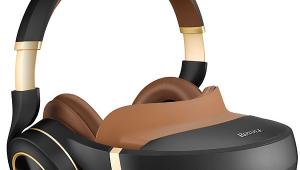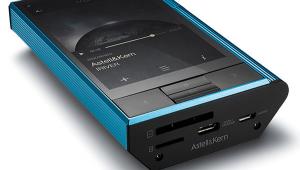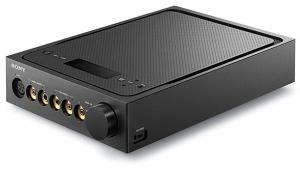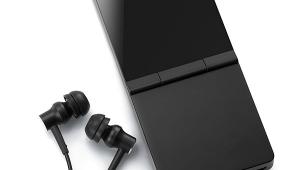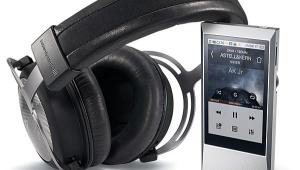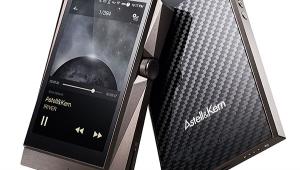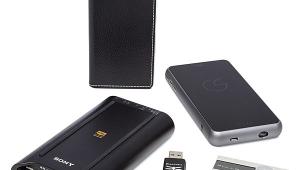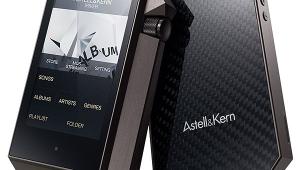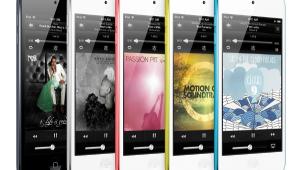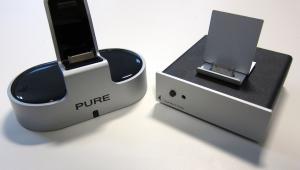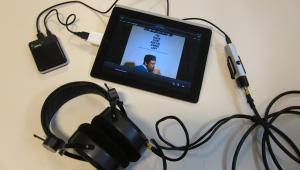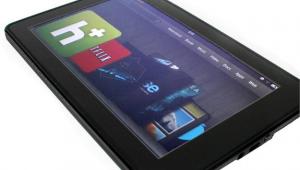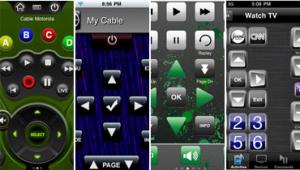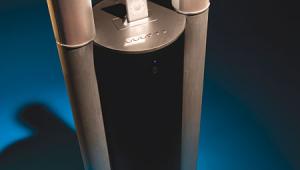Questyle QP1R Music Player Review

AT A GLANCE
Plus
Three gain settings
Heavy build and discrete components
Clickwheel nostalgia
Minus
No touchscreen or apps
No input for DAC use
No Bluetooth
THE VERDICT
Although short on some bells and whistles, the Questyle QP1R is a dedicated music player that offers four-figure sound and build quality at a three-figure price.
If you had chucked me into a time machine a decade ago, freed me today, then handed me the Questyle QP1R, naturally I’d mistake it for an iPod on steroids. With that clickwheel, it’s got to be an iPod, right? You’d have to explain to me that what Questyle calls the steering wheel isn’t identical to Apple’s clickwheel; here, the functions are divided differently among the wheel, its big central button, and the four vibrating touch-sensitive buttons around it.
My second reaction would be: Wow, this is heavier than an iPod. You’d have to explain that this high-end music player stuffs its rigid machined-aluminum chassis with lots of audio circuitry; the analog output section even utilizes discrete components. That requires some real estate, but it enables the player to audibly outperform a smartphone.
Then I’d say: What’s a smartphone? You’d realize that you had chucked me into the time machine just before the iPhone’s debut and that this is going to take some real splainin’. But instead, you’d plug a great pair of headphones into the Questyle and say, just listen.
 From Foxconn with Love
From Foxconn with Love
Questyle has divisions in both China and the U.S., and markets audio gear in 20 countries across Europe and Asia. The company’s products—along with some of Apple’s—roll off the assembly line at Foxconn, their OEM in China. Questyle is well versed in current mode amplification and brings that expertise to products that include a stereo power amp, a preamp, two headphone amps, a wireless media player, a digital-to-analog converter, and two hefty pocket-sized music players. The main benefits of the QP1R ($899) over the QP1 ($599) include internal capacity doubled
to 32 gigabytes, more hand-picked components, lower output impedance to drive more demanding headphones, and lower distortion. It’s also said to actually sell better.
The QP1R’s space-gray or champagne-gold aluminum case is covered on the front with Gorilla Glass. Surrounding the wheel and its center button are four touch controls for home screen, folder navigation, back, and forward. They can be set to vibrate, adding a helpful tactile response. On top are a headphone minijack and a second minijack offering a choice of analog line or digital optical output (the latter with supplied adapter). The knurled volume knob—or “mechanical helm volume control,” in Questyle-speak—is protected by jutting structures sculpted as part of the chassis, leaving it accessible by thumb in front or forefinger in back. On the right side is a power button that also flips the display on and off. On the bottom are a USB Micro-B port, for charging and file loading, and two microSD card slots, augmenting the 32-GB internal storage with up to 200 GB times two (the published specs say 128 GB, but Questyle says that’s wrong). There’s no Bluetooth capability, nor a digital input that would allow the QP1R’s internal DAC (based on the Cirrus Logic CS4398 chip) to be used with other sources.
Simplicity is this player’s merciful watchword. This is a music player, not a media player, and its 1.75 x 1.5-inch display is not a touchscreen. While this reduces functionality—no apps here—it also flattens the learning curve. There’s only so much to learn. No special software is required to load music. Just drag and drop from your computer. The unit charges in four hours with a standard phone charger or in eight hours via computer. A charge provides eight to 10 hours of playing time.
Questyle says that their unusual, patented, and patiently refined current mode amplification—used throughout their product line—allows wider bandwidth and lower distortion, while employing less negative feedback than the more traditional voltage mode amplification. This take on pure Class A circuitry results in higher performance. Discrete transistors and other components are part of the recipe.
The player provides three gain modes to accommodate a variety of headphone loads. I used the high mode, which ran all the headphones I tried at less than half of the available volume range. I didn’t need to resort to lower modes for fine-tuning because there were more than enough increments in the volume control, with gentle click-stops in the knob and hairline graphics in the display. Questyle offers suggestions for the gain control setting for some popular headphones in the Download section of the company’s website.

I reviewed the QP1R with a trio of headphones: HiFiMan Edition X ($1,799, reviewed in this issue), Sennheiser HD 600 ($400), and Sony MDR-V6 ($110). The lossy tracks were classical guitarist Narciso Yepes, Sonata K. 34—Larghetto, Scarlatti Sonatas (iTunes AAC); Steve Winwood, “Horizon,” About Time (MP3, 192 kilobits per second), and Jefferson Airplane, “White Rabbit,” Live at the Fillmore East (MP3, 192 kbps). The CD-quality tracks, all ripped in Apple Lossless, were Richard Thompson, “She Never Could Resist a Winding Road,” Still; Steely Dan, “Deacon Blues,” Aja, and the second movement of Brahms’ Ein Deutsches Requiem with Mariss Jansons leading the Royal Concertgebouw Orchestra and Netherlands Radio Choir. The high-resolution tracks were pianist Arthur Rubinstein, Scherzo No. 1 in B minor, Chopin: Ballades & Scherzos (FLAC, 176.4/24); Herbie Hancock, “Watermelon Man,” Head Hunters (DSD), and Billie Holiday, “You’ve Changed,” Lady in Satin (DSD). It was comforting to know that this is a true DSD player—one that handles DSD natively, with no conversion to PCM.
I had reservations about ergonomics, aggravated by my own clumsiness. Occasionally, when accessing the volume control from the front, I managed to activate the glass-topped touch-sensitive controls with the palm of my hand. Or my thumb would slip off the steering wheel and press one of them. I was warned that the wheel can be slippery; the designers need to give it a grippier texture. [Ed. Note: Questyle says they now have a transparent skin for this that ships with new units and can be supplied to existing owners free of charge.—RS] There was also a slight lag in the action of the volume control, which made me overshoot and vacillate until I learned to be patient with it.
Discretion Advised
Restraint and refinement are what define this player. That means a
top end that’s neither laid-back nor splashy, but clean and uncolored, methodically mining detail in hi-res content. The midrange has a close-up perspective that images voices brilliantly without inducing fatigue (at least, with two of the three headphones I tried). The bottom end is tight and doesn’t add any kick
to the bass in the bits. That would help if your headphones have an emphatic or under-controlled bass response, but not if they need bass reinforcement.
The Questyle seemed most at home with the Sennheiser HD 600 headphones, stressing their solid imaging and fulfilling their potential for high listening comfort. I’ve heard the Chopin piano selection through a variety of gear and have sometimes found its loud opening chord jarring and the rest glassy and hard. The Questyle/Sennheiser combo made the opening dynamically potent but not fatiguing, and it imaged the rest crisply but without undue edge enhancement. In the Brahms movement, the orchestra and chorus were sweet and colorfully textured. Even the Yepes guitar transcription of the Scarlatti sonata—a 1985 recording in iTunes AAC lossy format—was realistically defined. Given the lossy format and early digital recording, I expected less and tried to pick it apart, but the worst I could come up with was a shortage of woody resonance and a slightly foreshortened decay (the latter proving to be headphone dependent).
The Questyle/Sennheiser combo was vocally coherent in exactly the ways that artists likely have intended. In the Winwood track, the vocal was luminously realistic, with a slight echo that was discernible but firmly attached to the voice. The echoes in the Thompson and Holiday tracks were thicker and looser but still tethered to the voice. No one would mistake the Jefferson Airplane live track for audiophile material, but the mix does preserve the dynamic arc of Grace Slick as she builds up to the declamatory finale, and the Questyle/Sennheiser team made sure that rising volume didn’t mean rising discomfort. The only thing the Sennheiser and its small diaphragms failed to get from the Questyle was a meaty rhythm section (in the Steely Dan track, among others).
The Questyle was sometimes challenged by the Sony headphones. Their treble emphasis has been cruel to many otherwise excellent signal sources, but I learn a lot from it. The Chopin piano piece reverted to being glassy and hard. The Winwood vocal, so involvingly imaged by the Sennheiser, became off-puttingly peaky. Most tracks thinned out; that’s just how the Sony rolls, unless connected to a dark-toned source, and that’s not how the Questyle rolls. Yet the Questyle/Sony combo did have its share of great moments. The Scarlatti track’s acoustic guitar remained coherent; it was crisp but not frazzled. And the Hancock-on-DSD track came through with the kind of ingratiating warmth and smoothness I associate with good analog reproduction. “Play it loud!,” I told my notebook.
While the Sennheiser was the Questyle’s ideal mate in this group, the shiny player also harnessed some of the HiFiMan’s best qualities. The Chopin piano track flipped back from hard glaze to high resolution through these planar ’phones. The Scarlatti guitar track acquired a noticeably longer decay than the other two headphones supported. In the Jefferson Airplane track, the HiFiMan’s bass extension brought out both the bottom-end rumble and the top-end twang in Jack Casady’s bass. Steely Dan’s horn charts glowed, and certain elements leaped boldly out of the mix to tickle my pleasure centers. “Cymbals!,” I wrote in my notebook. “Guitar solo!” In the Holiday DSD track, the Questyle/HiFiMan combo knitted together all of the sometimes warring elements—searing voice, canned orchestra, both slathered in echo— to produce a wholeness that made me write, “It’s music again.” Hancock in DSD brought me to a place that was beyond analysis. I put down the pen and just grooved.

If you don’t want to listen to music on a smartphone—but don’t want to spend more than three figures for a hi-res-friendly music player—then the Questyle QP1R hits the sweet spot just below $1,000. It’s well built, thoughtfully engineered, and easy to use. And its clean, smooth, just-the-facts voicing favors headphones with a relatively neutral balance of frequencies, regardless of their electrical demands. If your iPod just died and you’re looking to step up to something better, this music player makes hi-res easy.
- Log in or register to post comments

